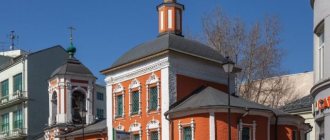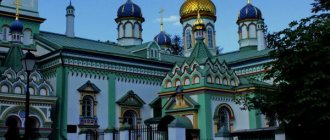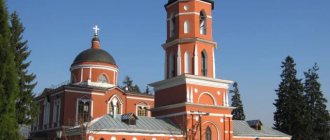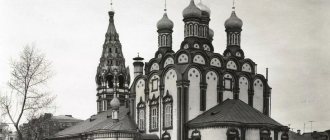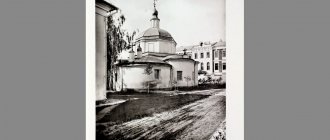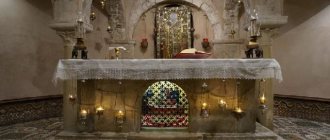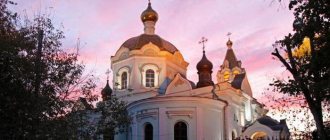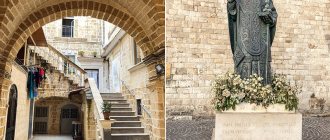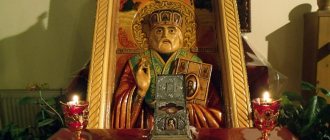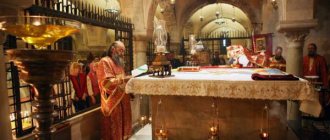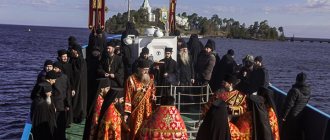The life of the fighter against paganism, Nicholas the Wonderworker, describes numerous miracles that he performed with divine help during his earthly journey. And after his repose, the saint came to the aid of suffering Christians in difficult times.
Since ancient times, the Bishop of Myra has been revered in Rus'. The Pleasant of God patronizes sailors, travelers and pioneers. The farmers also hoped for the help of the Saint. Throughout the Russian land, churches were erected in honor of St. Nicholas. And in the ancient village of Klyapovo the St. Nicholas Church appeared.
History of the temple
The church in the name of St. Nicholas the Wonderworker is located in the village of Nikolskoye, located 4 km north of the town of Kubinka, Odintsovo district, Moscow region. Initially, as chronicles of the 14th century testify, the village was called Klyapovo. Then, after the construction of the temple, the village began to be called Nikolsky-Klyapovo. In government records dating back to 1852, the settlement is simply called Nikolsky.
The first mention of St. Nicholas Church is found in the spiritual message of Prince Ivan the Red, who bequeathed Moscow possessions to his wife Alexandra in 1385. In 1586, Tsar Fyodor Ioannovich transferred Klyapovo to the Trinity-Sergius Monastery. The monks describe the parish church as a four-walled wooden frame.
The books of the monastery record that the temple is provided with holy images, candles and lamps, and liturgical books. Various bells hang in the belfry. Priest Karp, deacon and sexton lived on the territory of the church. There was also a hospice house for the poor here.
Historical fate
In 1764, Catherine II carried out a secularization reform in the Russian Empire. Part of the monastic property came under state control. Nikolskoye became a secular village. In 1805, a stone building was erected on the site of the wooden church. The State Property Register of 1852 mentions the brick church of St. Nicholas.
In 1933, by order of the Bolshevik leaders, the bells were removed from the bell tower. Three years later the temple itself is closed. Some church utensils and precious icons are confiscated. The remaining property is stolen. During the war, the premises are used by cavalry units as a stable. Then a grain storage facility is installed here.
Until the 90s of the last century, the building was empty. Without doors, with broken windows, the abandoned church gradually collapsed. The plaster on the walls was crumbling, and the marble slab floor was stolen by local residents for household needs.
Current situation
In 1999, restoration of the temple began. At the origins of the revival stood Archpriest Georgy (Studenov) and a native of Nikolskoye, M.V. Vanin. The first services were held surrounded by scaffolding. Father George turned to His Holiness the Patriarch with a request to change the status of the church. By order of Alexy II, the former parish church was included in the Moscow diocese as a patriarchal metochion.
December 28, 2003 is a significant date in the life of St. Nicholas Church. On this day, after the Divine Liturgy, which was celebrated by Bishop Feognost of Sergiev Posad, the bishop's consecration of the renovated church took place. Patriarch Alexy II was present at the ceremony and gave the church an icon of the Kazan Mother of God with a dedicatory inscription on the icon case.
Since January 10, 2013, Father Kirill (Osharov) has served as rector of the Church of St. Nicholas of Myra.
Nikolskoye, located in the upper reaches of the small Setunka river, a few kilometers north of Kubinka, is one of the oldest villages near Moscow and was formerly called Klyapovo
.
In the spiritual letter of the father of Dmitry Donskoy, Grand Duke of Moscow Ivan the Red, it was mentioned for the first time in 1358 as Klyapovskoe, intended for the lifelong possession of his wife Alexandra as a palace fiefdom of the Zvenigorod district.
The village was a very large economic complex, to which numerous villages were “pulled”, and was the center of a separate volost. Klyapovo remained among the princely possessions throughout the 14th-16th centuries, until 1584, when, after the death of Tsar Ivan IV, his son Theodore transferred the village to the authorities of the Trinity-Sergius Monastery.
The name Klyapovo was transformed into Nikolskoye after the church of St. Nicholas the Wonderworker built here. Moreover, the first church appeared here a very long time ago. In 1624 there were “at the church in the courtyard of priest Yakov, and in the village there were 12 peasant households, 14 people, 8 Bobyl households, 4 quarters of plowed land, 6 quarters of fallow land in the field, 10 kopecks of hay.”
.
Further, the existence of the St. Nicholas Church in the village of Klyapov is known from the parish books of the Patriarchal Treasury Prikaz for 1628 - 1740. There, in the article under the tithe of the Trinity estates for 1628, “the Church of St. Nicholas the Wonderworker in the village of Klyapovo ...”
.
However, even in our time Nikolskoye is the center of a large rural settlement in the Odintsovo district of the Moscow region. Of the ancient villages that were once part of this vast domain, only the Chapel has survived to this day; in Soviet times, due to its “church” name, it was renamed Chapaevka. The remaining towns and villages included in the rural settlement of Nikolskoye have a younger pre- and post-revolutionary history.
The undoubted “trademark” of these places, perhaps not only on a Russian, but also on a global scale, is the famous airfield (known as the airfield in Kubinka) and the “Russian Knights” and “Swifts” aerobatic teams based on it. The pilots and their families live in the so-called Old and New Towns of the rural settlement of Nikolskoye. If you drive from Nikolskoye and the Church of St. Nicholas the Wonderworker towards Mozhaiskoe Highway, then your attention will definitely be attracted by the monument to the MIG-21 fighter with a real aircraft mounted on a granite pedestal (modification of the MIG-21 FL). It is worth noting here that the choice of fighter is not accidental - it is the Soviet multi-role fighter MIG-21 that is recognized as the most common supersonic combat aircraft in the world.
The undoubted decoration and spiritual center of the village has long been the Nikolskaya Church, the full modern name of which is “Church of St. Nicholas of Myra, Patriarchal Compound in the village of Nikolskoye”
.
In 1805, “through the diligence of the Moscow 1st guild merchant Timofey Petrov and the support of his church parishioners,” the now existing stone church of St. Nicholas with the chapel of St. Sergius of Radonezh was built.”
The stone temple was built in a classical style and was warm. There was a stove in the basement. They heated it so that the floor in the temple was “like fresh milk.”
In 1871, the parish trustee built a stone shelter at the church for the poor parishioners. In the almshouse, rootless old people were cared for, and beggars spent the night. They were supported solely by voluntary donations from local residents - at the church gate there was an icon with a piggy bank.
In 1875, the trusteeship of the orphanage building added a second, wooden floor to house a rural school. In 1886, the same trustee built a wooden house for the parochial school. In 1895, a parochial school was opened. In 1909, 44 people studied there. The head of the school was priest T. Smirnov, the trustee was Princess O.A. Shcherbatova.
In 1910, Father Timofey Smirnov served in the St. Nicholas Church, and Alexander Arkhangelsky was the psalm reader. One of the last rectors of the St. Nicholas Church was Archpriest Alexander Mikhailovich Tsitserov.
The Tsitserov family (the family of the rector of the temple) accidentally preserved two remarkable documents. These are certificates of fundraising in the village of Nikolskoye and in the village of Troitsk for charitable needs in 1910. The peasants donated from their not so large incomes to the construction of churches and schools for immigrants to Siberia and to the military charitable society of the White Cross.
Alexander Tsitserov came from peasants, was a teacher, and graduated from a seminary. Father Alexander bought a house next to the church, the farm had a horse and a cow, and he plowed it himself. His wife Sofya Aleksandrovna Ritter (1892-1983), the daughter of a Moscow photographer, baked prosphora and milked the cow. The family had seven children.
After its closure during Soviet times, the church retained greenish paintings for some time. The Savior was visible on the dome. The floor was paved with marble tiles - after the closure of the temple, many people dug them out for household needs. The temple was surrounded by a beautiful stone fence mounted on stone pillars. After the war, these pillars were used for construction.
For a long time, there were tombstones lying on the territory of the temple - in the cemetery, one of which, according to recollections, was dated 1642.
Eight bells hung on the bell tower. Each had a name: “Big” - 316 pounds, “Parental” - 110 pounds, “Firefighter” - 40 pounds, and five more smaller ones. On Holy Week, everyone, according to the ancient tradition, climbed the bell tower to ring the bells. When there was a fire, they rang the Fire Bell, and then the Bolshoi Bell. They rang the bells wherever it was on fire in the area. They came from everywhere to help. In a special barn, a standby horse was kept ready in a collar, and there was also a pump there. Thatched roofs often burned.
In 1933, a special team of three men, from Ryazan or Vladimir, who were skilled in removing bells, came to the village. With amazing ease, using a three-pound weight, they knocked off the lugs of the Big Bell, threw it off and broke it. They did the same with Parent and Fireman. The frightened people remained silent - they would imprison you. They only asked to leave the Fireman, they left the smallest one.
The building of the Nikolskaya almshouse was dismantled in 1936. At the same time, the temple was closed, and the rector of the temple, Archpriest Alexander Tsitserov, was soon transferred to the village of Golitsyno, then in 1937 he was arrested and exiled to the camps, where he subsequently died.”
Then the gold removal specialists arrived. The remaining icons and iconostasis were burned right in the altar, and gold was mined from the ashes. They brought special baths, hired young people - gave them mittens, asked the children to help - in exchange for candy. They washed gold off various objects with aqua regia (a mixture of hydrochloric and nitric acids).
In April 1937, after returning from imprisonment in forced labor camps (in 1935) and serving in the Taganka Church in Moscow, Archimandrite Joasaph (in the world Ivan Vasilyevich Boev, 1879-1937) became the new rector of the St. Nicholas Church.
His story is also tragic. In 1912, in the Berlyukovskaya hermitage (now in the Noginsk district of the Moscow region), he took monastic vows. In 1914 he was ordained a hierodeacon, in 1921 a hieromonk, and served in the St. Nicholas Monastery of Edinoverie in Moscow. In the same year, he was mobilized into the militia as a beekeeping specialist and worked in an apiary.
In 1927, he was arrested on false charges of counter-revolutionary agitation and for bringing children into the church, after which he was exiled to the Tobolsk region. After the end of his exile, he moved to Ufa, where he served in the parish and established parish life.
In 1930, he was arrested on charges of “leading a counter-revolutionary organization of churchmen” and exiled to camps for 3 years. After his release and moving to Nikolskoye, on November 27, 1937, he was again arrested on charges of counter-revolutionary activities.
Father Joasaph categorically refused to plead guilty to the false accusations brought against him, but on December 5 he was sentenced to death, and on December 10 of the same year he was shot at the Butovo training ground near Moscow.
After the church was closed, children were baptized at home. After the war, when churches began to open again, they took children to be baptized in Sharapovo, in Perkhushkovo. They were also baptized at home in Nikolskoye.
Not far from Nikolskoye there was a Holy Well. Before the church was closed, during the Epiphany procession they went there to bless the water. The well was a log house, lined with blue boards, placed above a spring. He was located inside the chapel. There were many icons around and lamps were burning. An old man was watching. Neighboring residents brought sick children here and bathed them in spring water, and left their clothes in the chapel. Many people remember that there were a lot of caps lying inside, “vests were floating.”
Until the 90s of the last century, the building was empty. Without doors, with broken windows, the abandoned church gradually collapsed. In 1999, the restoration of the temple began and on December 28, 2003, the bishop's consecration of the repaired temple took place.
Architecture and decoration of the building
The Church of St. Nicholas the Wonderworker in Nikolskoye was built at the expense of the Moscow merchant T. Petrov. Donations from parishioners were used to furnish and decorate the premises. The face of the Savior was painted on the dome. A stove was installed in the basement of the building, which warmed the floor in winter. A two-story house was erected next to the church, housing an almshouse and a parish school. The church yard was surrounded by a wrought-iron fence on massive stone pillars.
Appearance
The building, built at the beginning of the 19th century, complies with the rules of the classical style. The one-story building is covered with a hip roof, topped with a single dome on a drum. A four-tiered bell tower rises above the porch. The main altar is consecrated in the name of God's saint Nicholas of Myra.
In 1904, the premises were expanded according to the plan of the architect N. N. Blagoveshchensky. The size of the refectory has increased. On the left and right, chapels were built in the name of St. Sergius of Radonezh and the biblical prophet Elijah. The interior walls of each chapel are covered with paintings depicting scenes from the lives of the holy righteous.
Eight bells of varying sizes and weights were suspended on the two upper floors of the belfry. Each bell had its own name. According to ancient custom, on Bright Week, any parishioner could climb the bell tower and become a bell ringer for a while.
The largest bells of St. Nicholas Church:
- “Big” - 5176.08 kg;
- “Parental” - 1801.8 kg;
- “Firefighter” - 655.2 kg.
Temple shrines
In every Russian church, relics that are worshiped by Orthodox parishioners and pilgrims are preserved and protected. The Church of the Pleasant of God in Nikolskoye is no exception. There are two monuments in the churchyard. A memorial cross was installed at the site of the reburial of the remains discovered during the restoration of the temple. In the summer of 2013, a granite slab with the names of the spiritual mentors who served in the church was installed and consecrated.
Revered shrines in the Church of St. Nicholas:
- Icon of the Bishop of Myra, found in the 16th century.
- The image of the Mother of God "Andronikovskaya".
- "Smolensk" icon of the Virgin Mary and Child.
- Locally revered icon of the holy martyr Alexander (Tsitserov).
The image of St. Nicholas the Pleasant is decorated with rings, crosses and beads. These are the gifts of parishioners who received help from the Saint. The icons of the Mother of God were preserved in the church until its closure during the era of Bolshevik persecution. Pious villagers managed to protect the relics from desecration. With the revival of Orthodox traditions, divine images returned to the temple.
The last rector before the closure of the church by the communists was Father Alexander (Tsitserov). By the resolution of the Holy Synod of July 16, 2005, the priest was canonized as Russian confessors and new martyrs. On September 9, 2012, on the day of remembrance of the saint, the icon of Father Alexander, on which his pectoral cross is attached, was installed in the church.
St. Nicholas the Wonderworker in the village of Nikolskoye, temple
May 22, 2022
1999.04 Church of St. Nicholas in the village of Nikolskoye. Photo by Andrey Agafonov
The Church of St. Nicholas the Wonderworker is located in the village of Nikolskoye, Voronovskoye settlement, Trinity District.
Object of cultural heritage of federal significance.
Description:
- The pillarless, vaulted, single-domed church with a refectory is made in the traditional forms of small parish churches of the 17th century,
- The architecture of the temple is distinguished by the amazing perfection of proportions (without a bell tower) with simplicity and modesty of decorations.
- A three-tier bell tower was added to the temple in the middle of the 18th century. In the lower tier of the bell tower there is a cross vault. The white-stone spiral staircase to the second tier is located in the thickness of the western wall of the refectory; the entrance to it is from the outside.
- Preserved in the temple are voice boxes - pots embedded in the vault to improve acoustics - and an ancient type of window frames with the method of their fastening. The tyablo iconostasis of the 17th century has also been preserved in the temple.
- The refectory is adjacent to the quadrangle (main volume).
- The building has a traditional three-part layout with a composition symmetrical relative to the longitudinal axis.
- The temple in the form of a double-height quadrangle with an original hipped roof is completed with a blind octagonal drum with a bulbous dome. The semicircular apse and the rectangular refectory are equal in width to the quadrangle. The three-tier bell tower consists of two square tiers in plan and an octagon of bells. A fairly restrained decoration of the facades with angular blades, a curb and one tier of semicircular kookshniks is characteristic of the second half of the 17th century. The decor of the bell tower is made in the traditions of provincial baroque. The internal ceilings are vaulted.
- The quadrangle is covered with a closed vault, the apse is covered with a conch, and the refectory is covered with a semi-tray vault.
- One of the most revered shrines of the temple was a life-size icon of the martyrs Cosmas and Damian, and in the refectory a chapel was built in their honor, in which they served in the winter.
- The temple has not been rebuilt since its construction, which makes it a unique historical and architectural monument.
From the history:
- The temple was built in 1692 by the owner of the village, stolnik Feodor Ivanovich Potemkin, who died in the Azov campaign of Peter I.
- In 1937, priest Dimitri Malin was arrested and exiled to a camp. He returned and died in 1938.
- The temple was closed by the Soviet authorities in 1937, only occasionally funeral services were held there.
- The large bell in the bell tower was broken into pieces.
- The forged brick fence was broken and used, along with the remains of the destroyed temple in the village. Chirikovo, during the construction of a bridge over the Pakhra River.
- However, the temple did not undergo complete destruction in those years, and for some time, through the efforts of local residents, the interior, icons and church utensils were preserved.
- Later, the temple was destroyed, some of the icons and church utensils were transferred to the Andrei Rublev Museum of Ancient Russian Art and other churches in the Moscow region. For some time the temple was used as a granary.
- It suffered the greatest devastation in the 1970s. The building was damaged, the domes collapsed, but the walls were not destroyed.
- The restoration of parish life began in December 1995, when the first meeting of parishioners took place.
- In the summer of 1996, priest Alexy Bubnov was appointed rector of the temple.
- The first service in the temple took place on June 8, 1998.
Necropolis - family tomb of the Potemkin family in the temple (destroyed in the 20th century).
The “Russian Provincial Necropolis” of 1914 lists the following burials:
- Potemkin Alexander Sergeevich, major general, † 1769
- Potemkin Dimitry Fedorovich, state councilor, † 1748
- Potemkin Evgraf Sergeevich, ensign of the Semenovsky Life Guards Regiment, † 1755
- Potemkin Sergei Dmitrievich, major general, † 1772
- Potemkin Mikhail Sergeevich, lieutenant general, general kriegs commissar, actual chamberlain † 1791
- Potemkin Pavel, general-in-chief, actual chamberlain, count, † 1796
- Potemkina Elizaveta Sergeevna, maiden, † 1768
1987.07 Church of St. Nicholas in the village of Nikolskoye. Photo by Andrey Agafonov
How are the services held?
For any person, in the spacious temple there is a cozy corner where there is a feeling of heaven on earth. The beauty and splendor of St. Nicholas Church calls parishioners to repentance. Cleansing from sins makes the soul beautiful, as God created it at the creation of the world.
In the St. Nicholas Church, services are not held daily, but according to a schedule drawn up for the current month:
- On weekdays, the liturgy begins at 9 am. Evening service is at 17:00.
- On Sundays, from 8:00 there is a Divine Liturgy and prayer service, and at 13:00 the rite of baptism is performed. A public conversation before the ceremony is held the day before at noon.
The church participates in the social life of the parish. At Sunday school, children over 5 years old are taught the basics of Orthodoxy, music and drawing. The classes, which take place on Saturdays from 3:30 p.m., are taught by the priests of the temple. Pupils of the educational institution perform at rural festivals.
The Orthodox military-patriotic club organizes pilgrimage trips to sponsored military units, where young men of conscription age get acquainted with army life. The visits to the Kantemirovskaya Tank Division are especially memorable. The unit received an honorary name for the liberation of the village, which was owned by Dmitry Cantemir under Peter I.
Scheme of Nikolskoye Cemetery
Phones
+7.
You can order services at the church. Services for seriously ill patients include:
- unction;
- confession;
- Communion at home or in hospital.
With the assistance of Ritual.ru, when preparing an Orthodox funeral, you can submit funeral notes, order services and requests:
- funeral service at home, in church, as well as in absentia;
- funeral service;
- forty
Set for burial in the Orthodox tradition:
A blanket (shroud), a halo on the head, a pectoral cross, a cross in the hand, a sheet with the text of a prayer of permission, an eight-pointed gravestone cross.
Average donation amount for a funeral service in a church
According to custom, during the funeral service they make a voluntary donation within their means. On average it is 2 – 5 thousand rubles.
FUNERAL ORGANIZATION
ACCORDING TO THE ORTHODOX RITE
More details
How to get to the church
Kubinka is the closest transport hub to the village of Nikolskoye. Railroad and highway routes pass through the urban settlement. In the south, the settlement is surrounded by Mozhaiskoye and Minskoye highways. The Smolensk direction of the Moscow Railway divides the city into northern and southern parts.
Temple address: Moscow region, Nikolskoye village, Kubinsky passage. The building is located between houses No. 53 and No. 63.
In your own car you need to drive 45 km along the Mozhaisk Highway from the Moscow Ring Road to Kubinka. In the city, after the road sign for the Solnechnaya Polyana boarding house, turn right. Along Nikolsky Proezd, the traveler leaves Kubinka and after a kilometer and a half, passing dacha villages, ends up on Zavodskaya Street in the village of Stary Gorodok. The main two-lane road turns into Kubinsky passage in the village of Nikolskoye. On the left side of the roadway before the bridge over the Setunka River there is the Church of St. Nicholas.
Electric trains run to Kubinka from the capital's stations. At the Belorussky station you can buy tickets for electric trains, which either pass through Kubinka or make their final stop here. The cost of the trip is 154 rubles.
You can get from Moscow to Kubinka by public transport.
- Minibus No. 457 runs hourly from the Park Pobedy metro station from 7:30.
- From here there is also a scheduled bus to Mozhaisk with a stop in Kubinka. The ticket costs 190 rubles. The journey takes 40 minutes.
- From the Tushinskaya metro station you can travel to Kubinka for 165 rubles by bus, which goes to the Vereya bus station. You will have to spend 1 hour 25 minutes on the route.
Bus No. 28 and minibus No. 83 go to the village of Nikolskoye from the village of Kubinka. The stop is at the railway station. Travel time is 9–12 minutes. In Nikolskoye, transport stops opposite the temple.
Estate NIKOLSKOYE-ARKHANGELSKOYE, Moscow region, Balashikha district
In princely times, the Yellow Pond was also called Luxurious. There were master baths on it. Not to say that the pond is big. About 500 meters in length and no more than 100 in width. But the place is very beautiful. And if you imagine that once upon a time it was possible to get from the Saltykov estate by boat to Izmailovo, where the country residence of the Russian tsars was located in the 17th-18th centuries? By the way, that’s how it was – we got there. Round trip. The Dolgorukov princes enjoyed the special favor of the teenage Tsar Peter II. Everything was heading towards the fact that the princes would become related to the royal family. The ambitious plans were prevented from coming true by the absurd and fleeting death of the sovereign.Prince Yuri Alekseevich Dolgorukov also took up the improvement of his lands and, using the Serebryanka River, planted a series of dams, dams, and locks on it, which formed a chain of beautiful ponds along its course. It was a kind of waterway through the estate. As a result of this reorganization, in the center of rich forest lands with a predominance of slender ship pine, oak, spruce, maple, and birch, a system of park complex management of a high artistic level was established.
According to various sources, there were from 11 to 13 ponds. One is better and more beautiful than the other. Their stepped cascade allowed for a simplified design of sluice dams. Drainage canals were dug in the swampy wasteland, dams were built, on which mills and factories, weaving factories and other enterprises were installed.
Before moving on to the description of the ponds and the history of their construction, it should be noted that the old Saltykovsky Park with its ponds began to be created in 1651 under Prince Yuri Alekseevich Dolgorukov and continued to develop until 1799 - 1800. The ponds were also not created immediately, but gradually.
Of particular interest are, of course, the Church Ponds, near the Church of the Archangel Nicholas (as the church is called in the Refusal Book of the 18th century). The church stood, as it were, on a peninsula, and the three ponds that once surrounded the temple were deep and connected by a canal with the Peasant Pond, which is in the southeast of the church. Previously, these ponds served as a reserve reservoir for the entire cascade of Saltykovka ponds.
Currently, only one pond has survived in the western part of the church territory; it is heavily overgrown and swampy. On the northern side the pond has been lowered, but the remains of the dam remain. From the side of the railway, under the bridge, a stream flows from north to southeast, which connects with the Serebryanka River.
The Peasant Pond previously adjoined the village of Nikolskoye and was separated from the Serebryany Pond by a dam (the height of the water rise was 2 meters). The dam on the quicksand was reinforced with piles and lined with trees. Nosovikhinskoye Highway runs along it. The road that passed along another dam to the villages of Rudnevo and Kozhukhovo was lined with linden and oak trees. Currently there is an extensive swamp. The remains of dams have been preserved, which have never been eroded in their history.
The Silver Pond was lined with silver poplars, which is how it got its name. In the sun, the water in it ripples silver. The banks here are artificial; the excavated soil was used to fill the islands. Once upon a time, the pond was decorated with an arched bridge that connected the forest road with the village of Nikolskoye. And on its southwestern side there was a pine grove.
In the hollow between the dam of the Silver Pond and the Yellow Pond there was the Princely Pond. In 1812, French supply detachments scoured the Moscow region in search of food supplies. The pond was drained, apparently assuming that there were a lot of fish there. Since then he has not recovered. The Serebryanka River flows from the Serebryany Pond to the Yellow Pond along the preserved bed of the Prince's Pond.
The Yellow, or Luxurious (the most beautiful) park pond has been well preserved, although in its lifetime it went into flood several times through a washed out dam (six times in 40 years). Because of this, the eastern and part of the southern shores of the pond are worn out by ravines that stretch to Tarelochkin Pond. During the reign of the Dolgorukov princes in the second half of the 17th century, on the shore of the Yellow Pond stood the village of Nikolskoye with a wooden church that burned down from lightning. There was a cemetery nearby, which is reminiscent of the remains of tombstones in the ground. The bottom of the Yellow Pond was covered with yellow sand, which is how the pond got its name. The banks of the ponds were reinforced with oak logs and lined with stone. The dam between the Yellow and Knyazhi ponds was reinforced with cages and brickwork and had an arched bridge.
Stepan Stepanovich Pond , which received its name from the tenant gardener, was previously a reserve reservoir for fish farming. It was connected to the Yellow Pond by a canal. Previously, there were berry fields here, which also ran along the shore of the Yellow Pond, where there is now a new park, between the dam and the Rus restaurant. The pond has now been drained.
The Sterlet Pond , where sterlet was bred for the princely table, was a continuation of the Yellow Pond. The 2nd diversion channel began here, directing the upper waters of the Yellow Pond to Sterlyazhiy. (A similar system can be observed in Gorenki). In some places, centuries-old trees have been preserved on the crests of the dams - a 200-year-old willow near the whirlpool of the (old) Tarelochkin pond stood there until 1963. On the small bank of the pond there was a princely beekeeper. The remains of the embankment - "Gorodishche" - have been preserved here. Old-timers consider it the remains of an ancient settlement. The stone slabs of the tombstones of an ancient churchyard previously lay near the dam itself.
Tarelochkin Pond, or Red , is named after the miller Tarelochkin, who had a mill here. On the shore of the pond there was a distillery and tavern building, and later a mill was built. The pond is located in the south-eastern part of Saltykovka, its length is 325 meters, width 25 meters (these are its modern dimensions). The bottom of the pond slopes to the east, towards the dam. Previously, the pond was inhabited by perch, pike, loach, char, bleak, and gudgeon. Traces of ancient settlements were also discovered on the left bank of the pond.
The Golden Pond got its name from the bottom, lined with golden-colored stone. It was once crowned with an arch on columns, decorated with ceramics. The bathhouses of the princes Dolgorukovs and Saltykovs were located here, and along the banks there were gazebos surrounded by golden maples. There were golden carp in the pond.
Kuchinsky Pond is mainly formed on the springs. Previously, Kuchinsky Pond fed Zolotoy Pond with water. Now this channel is cut by the railway.
This ends the cascade of Saltykov ponds, located along the bed of the Serebryanka River and the key system of Kuchinsky and Zolotoy ponds. However, the picture will be incomplete without mentioning two more ponds.
The Vishnyakovsky pond is formed by a dam on the Gorenka River (between the Gorenki and Chizhovo estates); it crosses the Razinskoye Highway on the northern outskirts of Saltykovka. This pond has also existed for almost 300 years and is one of the cascade of ponds of the Dolgorukov-Gorenki estate. At one time, on its bank there was a Vishnyakov cloth factory and a mill at the dam. In the 20-30s, a turbine power station was located here, supplying electricity to the entire district. [“Balashikha in essays and sketches” - M.: Modern notebooks, 2003].
